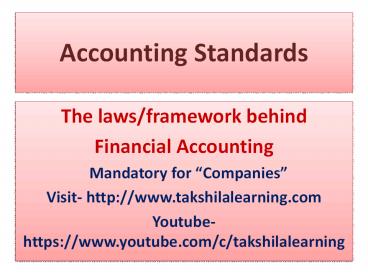Accounting Standards - PowerPoint PPT Presentation
Title:
Accounting Standards
Description:
Accounting Standards are Rules and Regulation of Financial Accounting set by ICAI (Institute of Chartered Accountant of India) which Cover the Treatment, Recognition, Measurement, Disclosure etc. It include the Objective, Benefits and Limitation of AS (Accounting Standard) Total 32 Accounting Standards are issued by ICAI. – PowerPoint PPT presentation
Number of Views:10399
Title: Accounting Standards
1
Accounting Standards
- The laws/framework behind
- Financial Accounting
- Mandatory for Companies
- Visit- http//www.takshilalearning.com
- Youtube- https//www.youtube.com/c/takshilalearnin
g
2
Definition
- Written policy documents- issued by
- Institute of chartered Accountants of India
- Cover aspects of
- Treatment Presentation
- Recognition Measurement Disclosure
3
Objectives (True Fair View)
4
Benefits
- Reduction in Confusion Easy comparison
- Disclosure of all informations
- ( including not required by statute)
5
Limitations
- Alternative solutions ( difficult choice between
standards) - Trend towards rigidity
- Accounting standards cannot
override the statute
6
Overview
- Accounting Standards
- Issued by ICAI Issued standards-32
- formulated by ASB set up on
21st April,1977 - In force standards-31
- Notified Standards 29 ( by
MCA)
7
Overview
- A draft is prepared of accounting standards after
comments from experts of various fields. - Advisory committee NACAS
8
List of Accounting Standards
- AS-1 Disclosure of Accounting Policies
- AS-2 Valuation of Inventories
- AS-3 Cash Flow Statements
- AS-4 Contingencies and Events Occurring after
the Balance Sheet - AS-5 Net Profit or Loss for the Period, Prior
Period Items and Changes in Accounting Policies - AS-6 Depreciation Accounting
- AS-7 Accounting for Construction Contracts
- AS-9 Revenue Recognition
- AS-10 Accounting for Fixed Assets
- AS-11 The Effects of Changes in Foreign
Exchange Rates - AS-12 Accounting for Government Grants
- AS-13 Accounting for Investments
- AS-14 Accounting for Amalgamations
- AS-15 Employee Benefits
- AS-16 Borrowing Costs
9
List of Accounting Standards
- AS-17 Segment Reporting
- AS-18 Related Party Disclosures
- AS-19 Leases
- AS-20 Earnings per Share
- AS- 21 Consolidated Financial Statements
- AS-22 Accounting for Taxes on Income
- AS-23 Accounting for Investments in Associates
in consolidated financial statements - AS-24 Discontinuing Operations
- AS-25 Interim Financial Reporting
- AS-26 Intangible Assets
- AS-27 Financial Reporting of Interests in Joint
Ventures - AS-28 Impairment of Assets
- AS-29 Provisions, Contingent Liabilities
Contingent Assets - AS-30 Financial Instruments Recognition
Measurement - AS-31 Financial Instruments Presentation
- AS-32 Financial Instruments Disclosures
10
Notes
- AS-8 Accounting for research development
withdrawn merged with - AS-26 Intangible assets
- AS-30,31 32 Not notified by Ministry of
corporate Affairs
11
Notes
- Applicability of Accounting Standards depends on
Level of Companies - Note Level 1 2 Small Medium Sized
Companies
12
Notes
- Level 1
- Turnover(excl other income) of 50 Crores or above
- Borrowings (incl deposits) 10 cr or more
- Listed companies or are in process of listing.
- Level 2
- Turnover(excl other income) of 40 lakhs-50Cr
- Borrowings (incl deposits) 1Cr 10 Cr.
- Level 3
- Companies other than in Level 1 2
- Notes All Accounting standards are compulsory
for Level 1 Companies. - AS-3,17,18,24 (only for Level 1 cos.)
13
Accounting Standard-1
- Disclosure of Accounting Policies
- accounting policies to be fully disclosed in the
- notes to accounts
- Selection of policies through -
- Prudence, Substance over Form Materiality
- No disclosure of Fundamental Accounting
assumptions - (if followed)
14
Accounting Standard-2
- Valuation of Inventories
- Valuation Cost/NRV whichever is lower
- (based on Conservatism Concept)
15
Accounting Standard-2
- Valuation to be applied on item by item basis.
- Cost of inventory
- Purchase cost
- Cost of conversion
- Cost of bringing the goods to the present
location of the factory - Net Realizable Value Realizable Value Selling
Expenses
16
Accounting Standard-3
- Cash Flow Statements
- Statement showing movement of Cash in out of
the business - through three activities
- Operating Activity Financing Activity
- Investing Activity
17
Accounting Standard-9
- Revenue Recognition- when work completed
- Recognition of revenue arising in the course of
ordinary activities. - Sale (recognized as revenue)
- Complete Sale Risks Rewards transferred
Consideration fixed - (Delivery done) to buyer
(guarantee of receipt)
18
Amendments
- To bring uniformity in Accounts round the world,
- International Financial Reporting Standards
are being applied worldwide. - India not applied IFRS till now, so have issued
- Converged AS- IND AS
- Applicable from 1st April,2016
- Listed Cos. and unlisted companies having
- net worth in excess of Rupees 500 crore
19
MCQs
- Q.1. AS-2 is on
20
MCQs
- Q.2. Accounting Standards
21
MCQs
- Q.3. As per AS-3, which of the following, should
be classified as an investing activity?
22
MCQs
- Q.4. Select the correct equation
23
MCQs
- Q.5. Revenue is generally considered as realized.
24
MCQs
- Q.6. The accounting standards are mandatory for
25
MCQs
- Q.7. Provision for bad debts is the application
of which of the following concept convention
26
MCQs
- Q.8. As per AS-1, the fact need not be disclosed
in the financial statements if the following
concept is followed.
27
MCQs
- Q.9. Economic life of an enterprise is split into
the periodic interval as per
28
MCQs
- Q.10. Selection of Accounting policies
appropriation is not based on

